A block of mass m1 hangs from an ideal rope attached to a block of mass m2 which sits on an incline of angle φ. Friction is present between the ramp and m2.
(a) Assume that initial neither block is moving. Draw a separate free body diagram for each mass.
(b) If the blocks are not moving, what is the magnitude and direction of the
(c) If the block are not moving, what is the smallest possible value for the coefficient of static frictionμsbetween the ramp andm2?

(a) Draw a separate free body diagram for each mass.
Free body diagram for m1
Diagram :

The forces acting on mass m1 are;
(1) Vertically downward force =F1=m1g (acted due to earth)
(2) Vertically upward force = Tension= T (Acted by a rope attached to mass)
As neither block is moving means, the system at rest; the forces add to zero.
T = m1g
Free body diagram for m2
Diagram :

The forces acting on mass m2 are;
(1) Vertically downward force m2g acted by the earth
(2) tension T along the rope on inclined ramp acted by rope
(3) Normal force N to the inclined ramp at an angle
Trending nowThis is a popular solution!
Step by stepSolved in 3 steps with 2 images

- A 27.0-kg block is initially at rest on a horizontal surface. A horizontal force of 74.0 N is required to set the block in motion, after which a horizontal force of 61.0 N is required to keep the block moving with constant speed. (a) Find the coefficient of static friction between the block and the surface.(b) Find the coefficient of kinetic friction between the block and the surface.arrow_forwardA 0.85 kg block of wood is stationary on an incline that is15◦above horizontal. A force of 3.0 N is being applied toit 75◦below horizontal, directly into the incline (the force isperpendicular to the incline). What is the minimum coefficientof static friction required to keep the block stationary?arrow_forwardAn 11 kg block is being pushed forward on a flat surface with a force of magnitude 45 N. The coefficient of static friction on the block is 0.15 and the coefficient of kinetic friction on the block is 0.12 (only one of these needs to be used). (a) Draw a free body diagram of the block. (b) What is the net force acting on the block? (c) What is the acceleration of the block? Ff FN E FODRarrow_forward
- A skier of mass 64 kg skis straight down a 12 degree slope at constant velocity. Draw a free-body diagram of the skier with the various external forces acting on her. Include the force of air resistance, which is directed opposite the velocity. (a) Find the value of the normal force. (b) The force of air resistance has a magnitude of 75 N. Find the frictional force on the skis. (c) What is the coefficient of kinetic friction?arrow_forwardA 6.49 kg block is at rest on a horizontal surface. Attached to this block is a massless, stretchlessstring. On the other end of the string is a hanging mass (mB). The coefficients of static and kinetic frictionbetween the block and the surface are 0.728 and 0.563, respectively. (a) Find the minimum value of mB that willcause the block to begin to move. (b) What is the acceleration of the block when the hanging mass is equal tothe value found in part (a)? (c) What is the acceleration of the block when the hanging mass is equal to twice thevalue found in part (a)?arrow_forwardFigure 1 В А Three blocks, labeled A, B, and C, are connected by essentially massless strings that run over essentially massless and frictionless pulleys (as shown in Figure A above). Block A hangs straight down. The string from block A connects to block B which is sliding up and to the left along an inclined plane. The plane is inclined at an angle of theta = 0 = 52 degrees away from vertical. The coefficient of kinetic friction between block B and the plane is 0.38. Block B is connected by a different string to block C which hangs straight down. Block A has a mass of 4.1 kg. Block B has a mass of 3.7 kg. Block C has a mass of 2.5 kg. Block A is moving down and block C is moving up (the strings do not stretch). The only significant forces acting on the blocks are friction acting on block B, normal forces, tension forces, and gravity (with g = 9.81 m/s²). Calculate the %3D acceleration (in units of meters per second squared) of block A. For block A, a downward acceleration is…arrow_forward